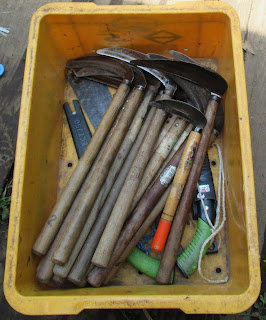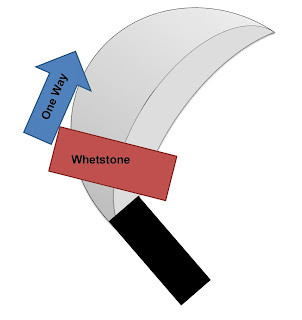We forest volunteers have a rule for standard attire when we do forestry. It’s to minimize the risk of injury. Shoes should be sturdy enough, and preferably with protective toes and soles against falling objects on foots. Covering arms and legs is the MUST to protect limbs during the activity with saws et al. Leather hand gloves are indispensable as it can prevent the tools from slipping. And helmet. Forest can be a precarious place where broken twigs, boughs, etc. could fall down on our head unexpectedly. Safety helmet is literally a life-line for us forest volunteers. Caution: “It is highly recommended not to wear imported helmets in Japan.” Trade restriction? Oh, no. Euro-American made helmets often do not have a chin strap. It would be OK without it in a flat forest floor of continents. In contrast, during our activity, it’s so easy for us tumbling down precipitous hills of Japanese forests. Do you remember the episode of my injury last year? I dropped 3m below and broke my right wrist. If I was unlucky enough I would have broken my skull è death. At that time, my helmet was at least secured enough to cover my head. Thank God, honestly.
 |
| That hurts … |
Because of this very aggressive (?) gear, once we put a waist belt dangling saws, scissors, and/or machete over this special costume, we feel a sort of elation. Hey, in the 21st century Japan when can we legitimately enjoy our style with edged tools on our waist, just like samurai with swords? It is whispered that a person can change his/her personality once s/he carries saw in a forest. It could be a reason we are so fascinated by Jason, Friday the 13th … (by the way, I don’t like that film.) Coming to the issues of swords of samurai, sharpness was decency for them even when they did not engage in a combat. To some extent, for us forest volunteers polish of our tools is beyond the etiquette. For one thing, dull edge of a saw is a recipe for severe injury. Besides, tackling forestry tasks with stupid devices is really a waste of energy (physical and mental) and time. So, taking care of our instrument is one of the most important things we have to do.
 |
| This, |
 |
| and this. |
Having said that, (1) our saws are often not that expensive, and (2) we do not have skill to whet saw. Confession. I’ve never sharpened my saw. After use, I simply clean my gear, and spray mineral oil to stop rusting. When time comes, I visit my nearby home center and bought a replacement, in less than 2000 yen ($20). Very interestingly, filing blades of motorized chainsaw is far easier. I’m doing it regularly. It has a guiding gage, easy to use sharpener, etc., you see? I’ve felt this situation somehow uneasy. So, one day, I attended a training session to learn “how to sharpen hand tools for forestry.” They did not tell us the way to file saw, but I’ve learned how to whet single edged sickles. I cannot declare I’m now an expert for this … but I have a kind of peace of mind thanks to this lesson. Here is what I’ve studied;
1. Before anything, preparation is necessary. DO wear gloves. Cotton work gloves with cleats are the best, as we work with water. Cotton gloves tighten our grip when wet, so that we can be prevented from injury by slipping a grindstone. Also, before start working, we have to submerge whetstones in fresh water for at least one or two hours. Reason? Sharpening stones for our hand tools are made of sedimentary rocks or tuff. They have lots of tiny cavity inside. We have to fill these spaces with water that can smooth the movement of filing.
 |
| A popular whetstone. Black side is normally used, and the red side is for a finishing touch. |
 |
| Can you see air bubbles coming out during the submersion? |
2. Position the prepared stone over the front side of the ENTIRE sickle, not only to the blade. Move the stone along the entire sickle, in a same direction. NEVER going back and forth. ONE WAY, please.
 |
| Before the procedure … |
3. It will create a shining trace of the stone at the outer edge of the sickle. It’s the sign of right way.
4. The backside of the sickle would have burrs. Using the stone, we just “wipe” them gently. NEVER grind the backside.
Er, well, if your sickle has so many chips in a blade, do sharpen your blade from the back until the chips are gone. Then, whet the front as above.
 |
| Admitting, some needs more elaboration from the back … |
After whetting, spray mineral oil, and they are ready. We don’t have to stick to mineral oil. EX olive oil will do the same, but it could be more expensive. 😉
 |
| It’s a popular spray of mineral oil. |
The work was very meditative … We have to concentrate on the task for avoiding injury from the sharpened blade. Also, too much polishing could wear down the entire tool. Stop at the best moment is the key. Focus, focus, focus … The result I could get from the task was strangely satisfying. I realized why there are many scenes in samurai movies where Japanese swashbucklers take care of their swords while in a contemplative conversation. Ah-ha. Yep, polishing your swords, even if they are not for samurai, but for forest volunteers of the 21st century, is VERY rewarding, especially when we’re stressed out in a rat race. Let’s sharpen our “knives” to relax more! … Plash, plash, plash, … (It sounds bizarre … subversive …)
 |
| Done! |
If you find an environmental issues
in Kanagawa Prefecture, please make a contact with Kanagawa Natural Environment Conservation Center 神奈川県自然環境保全センター
657 Nanasawa, Atsugi City, 243-0121 〒243-0121 厚木市七沢657
Phone: 046-248-0323






No comments:
Post a Comment